
In 2024, Rootjunky APK To Bypass Google FRP Lock For OnePlus Open

Rootjunky APK To Bypass Google FRP Lock For OnePlus Open
Factory Reset Protection (FRP) is a security feature built into Android devices running Android 5.1 Lollipop and later versions. It prevents someone from using your phone after a factory data reset without Google account login credentials. The FRP makes it much less attractive for thieves to steal Android phones, knowing they will need help to access them.
FRP automatically activates when you add a Google account to your Android phone. It links the OnePlus Open device to your account, making it the “trusted owner.” Once activated, FRP becomes embedded in the phone’s system.
While Google FRP is a valuable security feature, it’s vital to acknowledge that there are legitimate situations where bypassing it might be necessary. These instances include forgotten Google account credentials, buying a second-hand device, and device issues. In these cases, tools like RootJunky can help you bypass FRP Lock. We’ll explore how to use RootJunky APK later, but first, let’s define what it is and its role in FRP bypass.

The RootJunky APK is a free Android application also called RootJunky SDL or RootJunky FRP Bypass tool. This app’s primary function is to bypass the Google Account FRP lock on Samsung devices. Rootjunky uses the weaknesses in Android’s setup process to create a new user account or switch existing ones, letting you bypass the FRP and regain control of your phone.
You can complete this process using the app by connecting your phone to a computer through an OTG cable. RootJunky can be helpfu l if you’ve forgotten your Google account password or bought a second-hand phone locked to someone else’s account. However, only use it if you have legitimate reasons to bypass FRP lock, like accessing your device after forgetting your Google account details.

Downloading the RootJunky FRP bypass tool from unofficial sources can introduce malware risks, so stick to trusted sources like the official website. Additionally, when exploring RootJunky, it is vital to keep the following in mind:
- Not all Android devices are susceptible to the methods used by RootJunky. It is necessary to check compatibility with your specific device model and Android version.
- Using FRP bypass tools like RootJunkycan potentially compromise the security of your device. Be cautious and proceed if you fully understand the risks involved.
- Bypassing FRP may involve data loss.
- Download RootJunky FRP bypass APK from a reliable source to minimize the risk of malware or viruses. You can check the APK file from official websites or trusted forums.
- Google constantly updates its security measures, so these tools may not always work effectively.
Part 2: How To Use RootJunky To Bypass Google FRP?
Here are the general steps to use the FRP Bypass APK RootJunky app to bypass Google FRP lock. But remember that specific steps may vary depending on your device and Android version:
- Step 1: On your computer, download the Rootjunky RealTerm program from the official Rootjunky website.

- Step 2: On your phone, download the Rootjunky APK (com.rootjunky.frpbypass-1.0.apk) file from the official website or other reputable sites.

- Step 3: Go to Settings > Security and tap Install unknown apps. Then, enable unknown sources to allow installation of apps from outside the Play Store. Connect your device to a Wi-Fi network.

- Step 4: On your Android phone, open a file explorer app and install the downloaded RootJunky APK file.
- Step 5: Connect your smartphone to your computer using a USB cable.
- Step 6: Launch the Rootjunky RealTerm program on your computer. Under the Display tab, check the Half Duplex option.
- Step 7: On your computer, go to Device Manager > Modems. Locate your device’s port name (e.g., COM3).
- Step 8: On the RealTerm program, enter the correct port number under the Ports tab, then click Change.

Step 9: Click Send to establish a connection. Enter the two commands:
at + creg? \ r \ n
atd1234; \ r \ n
Step 10: Once connected, the Rootjunky APK on your phone will provide on-screen instructions to bypass FRP.
Step 11: If prompted, perform a factory data reset of your device.
While RootJunky offers a free method for FRP bypass, it can be incompatible with your device’s brand, requiring technical knowledge, tedious, and potentially risky. If you are looking for a simpler, safer, and more user-friendly solution, Wondershare Dr.Fone might be a better fit for you. If you want to learn how to use this tool to bypass FRP lock with minimal technical expertise, then keep reading.
Part 3: Easier Tool Than RootJunky APK To Bypass Google FRP
Google FRP adds an extra layer of security after a device reset. However, regaining access to the smartphone can be challenging if you forget your Google account details, forget your lock screen, or just buy a used device. While methods like the FRP RootJunky app exist, using it can be complex or risky.
Consider exploring third-party options like Dr.Fone for a potentially easier and safer FRP bypass solution. Dr.Fone Screen Unlock tool helps remove the Android FRP lock without requiring a PIN or Google Account.
Why Use Dr.Fone - Screen Unlock?
Here are some of the key features of Dr.Fone - Screen Unlock:
- **User-friendly:**Fone boasts an intuitive interface, eliminating the need for technical expertise. Even beginners can navigate the process with ease.
- **Widespread Brand Compatibility:**Fone supports mainstream brands, such as Samsung, Xiaomi, Oppo, Redmi, Realme, and Vivo, catering to a broader user base.
- **Fast and Efficient:**Regain access to your device in minutes without wasting time on tedious procedures.
Step-by-step Guide to Removing FRP Lock With Dr.Fone - Screen Unlock
Ready to leave the hassle of using RootJunky and easily bypass the FRP lock? Download and install Dr.Fone on your computer, then follow these steps to learn how to bypass Google FRP on your device:
- Step 1: Launch Dr.Fone on your computer and connect it to your Android device. Choose Screen Unlock from the Toolbox in the main interface.

- Step 2: Choose Android as your device type. This will take you to the next screen, where you can select Remove Google FRP Lock to proceed.
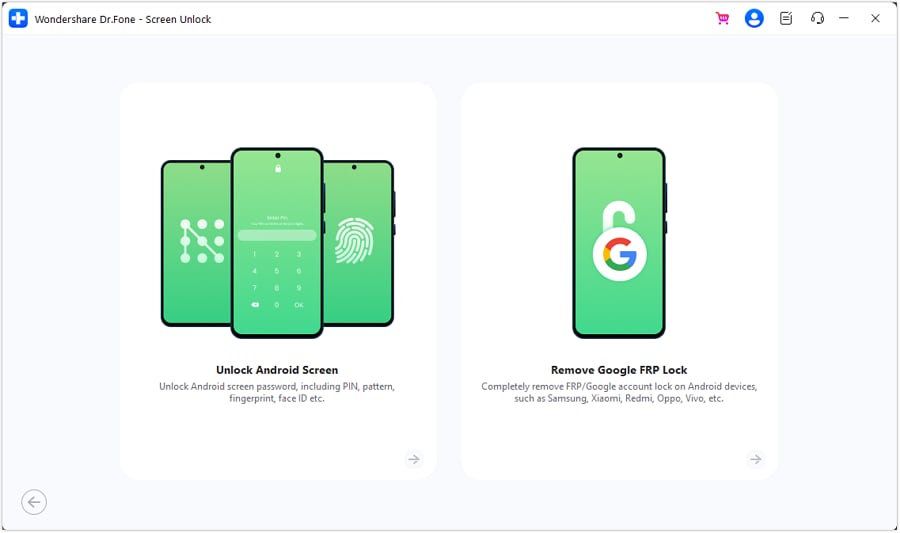
- Step 3: Select your device’s brand from the list and click Start to continue.
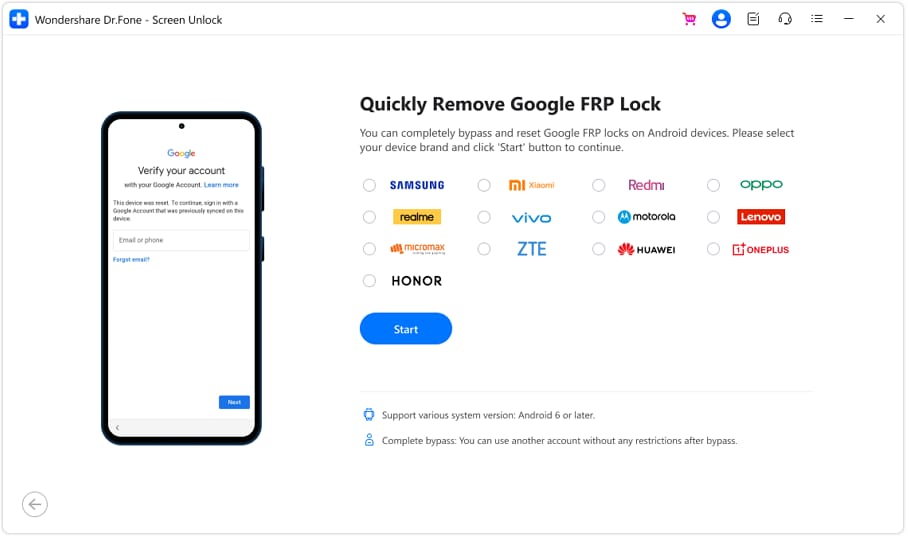
Note:
The next steps may vary depending on the brand you selected.
- Step 4: Select the OS version of your device and click Start to continue.
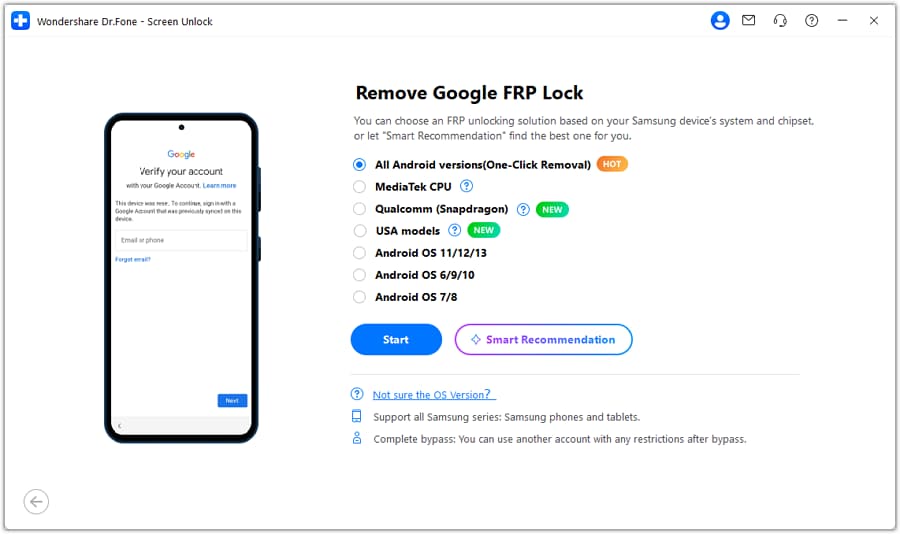
- Step 5: Access the secret menu on your phone using the on-screen instructions, then click Next to proceed to the next step.
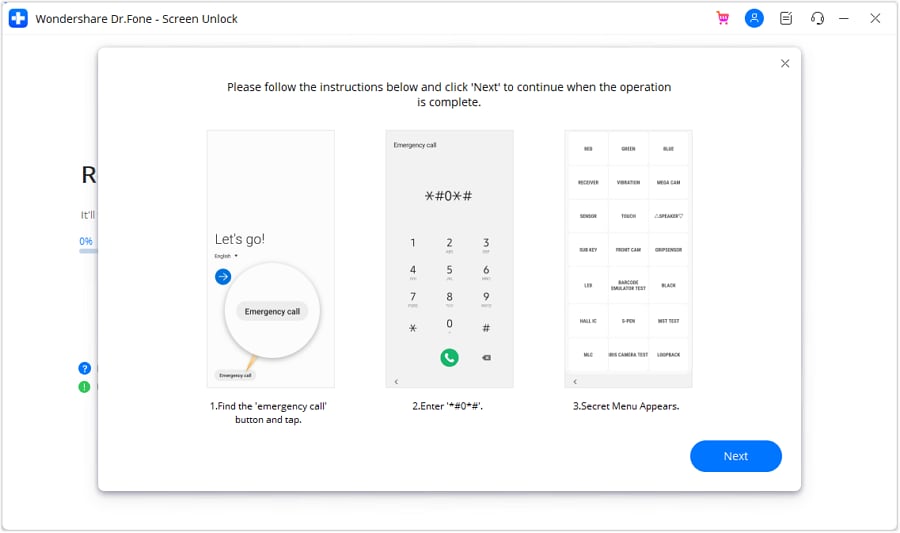
- Step 6: When your Samsung prompts you to activate USB debugging, tap Allow. Then, on your computer screen, click Authorized to confirm.

- Step 7: You will see the FRP lock being bypassed on your Android device on the next screen.
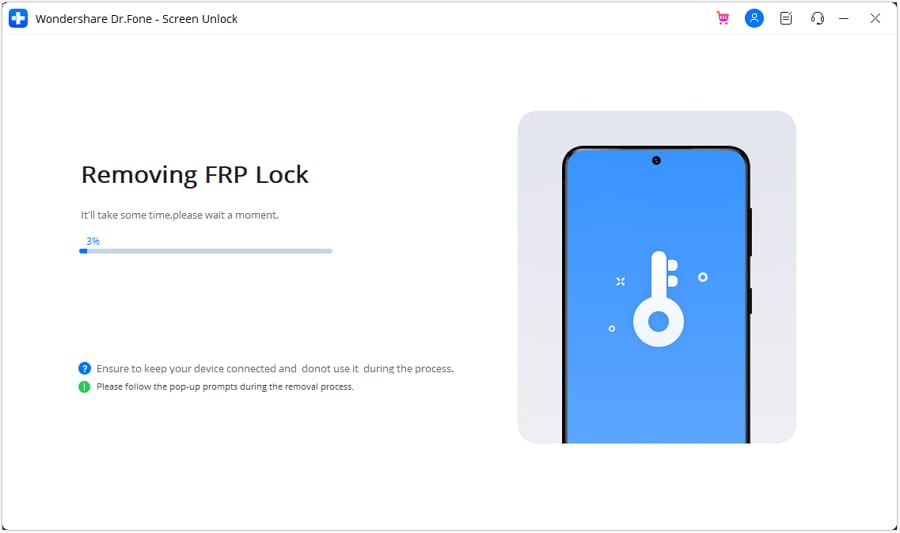
- Step 8: Click Done if the FRP lock removal was successful, otherwise, click Try Again to repeat the process.
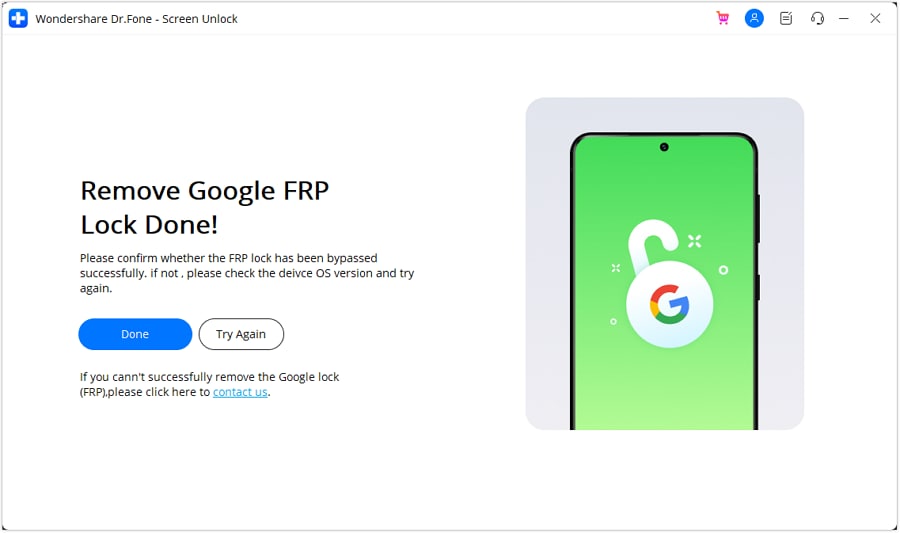
That’s it! With Dr.Fone Screen Unlock, you can easily bypass Google FRP and regain access to your Android device, leaving the complexities of RootJunky behind.
Tips: Are you searching for a powerful FRP bypass tool? No worries as Dr.Fone is here to help you. Download it and start a seamless unlock experience!
Conclusion
Both RootJunky and Dr.Fone offer options for you to regain control of phones with Google FRP lock. FRP Bypass RootJunky tool excels with its free-to-use approach, perfect for tech-savvy users comfortable with APK installations. While requiring a paid subscription, Dr. Fone provides pre-rooted firmware installations and broader device compatibility, which is ideal for those seeking a more streamlined but supported experience.
The best choice boils down to your personal needs and budget. Remember, FRP bypass should only be utilized by rightful owners facing genuine lockouts. When used responsibly, these tools can help you access your phone after a factory reset even without your Google account credentials. Choose the tool that best fits your needs and proceed with caution. Use these tools responsibly and regain access to your device the right way.
How to Show Wi-Fi Password on OnePlus Open
Since the invention of Android OS in 2008 by Andy Rubin, our world has faced a dramatic change. Android seems to be controlling a considerably high portion of our life. We have bought many gadgets that use this amazing OS and most of which are phones. But how much can you do with your Android phone? Developers are always making it more interesting to use this interface.
Most of the time, we use Android phones, we get faced with the need to access the internet. The Wi-Fi capability of these Android gadgets makes it super easy for us to surf the web. Throughout using Wi-Fi, we connect to a number of them. This could be at school, a sub-way café, the gym, buses, hospitals, hotels, towns, and the list is endless. A password secures most of this. Needless to say, our brain is weak to store all these passwords for future use, especially if you would want to connect with a different gadget you have recently bought or even your laptop. In this article, we will introduce you to how to find wifi password on rooted and also unrooted Android devices.
Part 1: Show Wifi Password on Rooted Android Device
What is Rooting?
First of all, what does rooting mean? You have probably used a Windows computer or even Linux. For the case of Windows, when installing a new program or software, it always prompts a dialog box saying, “Administrator permission required to run this program.” If you don’t have the administrator permission, you won’t install the program. In Android, this is called rooting. In simple terms, it means having the root permission to your phone. Some Android apps will require you the root permission, e.g., flashing your ROM. In this part, we will explain how you can show the Wi-Fi password on your Android with root.
To find the Wi-Fi passwords on your Android phone, you need to have an app to explore files which also supports a root user. In this case, ES FileExplorer or Root Explorer will come in handy. However, it turns out that the latter is offered at $3. Let’s use the free ES File Explorer.
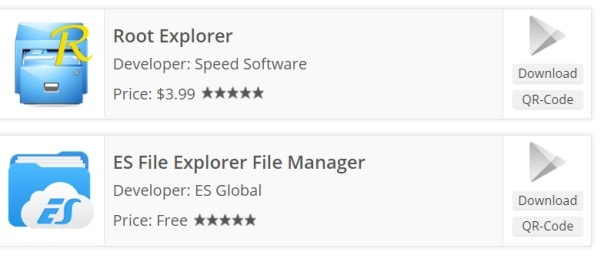
Steps of getting Wi-Fi password on Android with root
In only four steps, we, at this moment, learn how we can find the password of a Wi-Fi on an Android phone.
Step 1: Install the ES File Explorer
Download the ES File Explorer from your play store, install it, and open it.

Step 2: Enable Root Explorer
The root explorer needs to be enabled so that you can reach the root folders of the Wi-Fi passwords you need. By default, the root feature in this ES explorer is not enabled. To enable it, just tap on the list menu on the top left corner.:
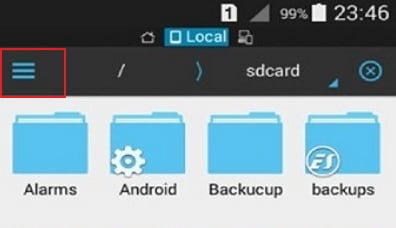
This will drop down a list of controls. Scroll down and find the Root Explorer option and enable it.
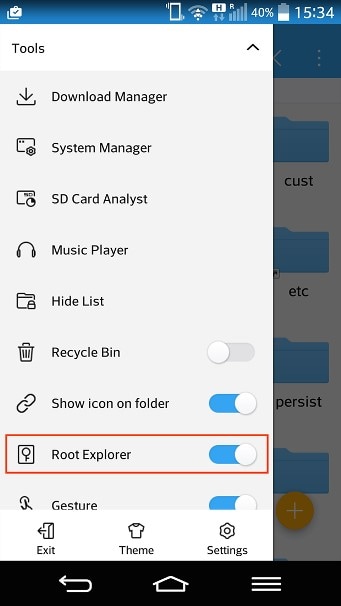
Step 3: Get the passwords’ file.
Go back to ES file explorer, and this time, find the folder named data.
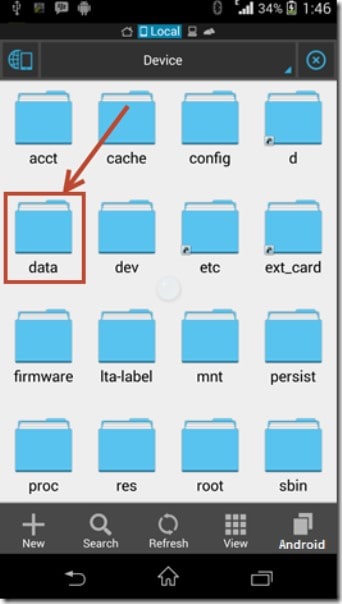
When this folder opens, find another one named misc. Open it and find another one named wifi. Here, find a file named wpa_supplicant.conf.

Step 4: Retrieve the wifi password on Android
Make sure that you don’t edit anything in the file. You might mess up with important data and fail to access the Wi-Fi(s) in the future.
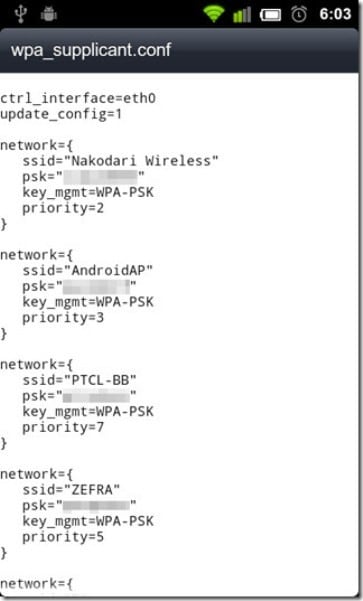
As you can see above, we have found the Wi-Fi passwords on the android device. On each network profile, we have the name of the network represented by name (ssid=”{the name}”), the network’s password represented by psk, the network’s access point represented by key_mgmt=WPA-PSK and its priority represented by priority.
Part 2: Show Wifi Password on Android without Root
What if I don’t have root access to my Android, can I still see Android Wi-Fi password? The short answer is yes. However, this is a bit involving but simple. You don’t need to be a computer guru to do it, but you need to have a computer and some internet access of course. The key thing is to find a way through which we can fetch the password file from the phone without using a root access protocol in the Android. This is made possible by some little programming insight using the Windows Command prompt.
Steps to show Wi-Fi password on Android without root
Step 1: Access the Developer authority
To access the files that Android uses to run passwords, you must first become a developer. This is very simple.
Get your Android phone and go to settings. Scroll down and find “About phone.” Tap on it and scroll down again to find Build number.

Tap on this “build number” 5 to 6 times until a message pops up, saying, “You are now a developer”.

Step 2: Enable the debugging.
Go back to Settings. Scroll down for developer options. Turn on the button for “Android/USB debugging”.
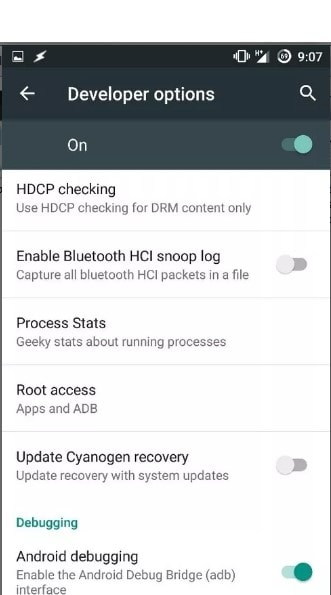
Step 3: Install ADB drivers.
Now, open your Windows desktop. Download and install ADB drivers. (Use this download link adbdriver.com ). You need to download and install platform tools (minimal ADB and fastboot) from http://forum.xda-developers.com/... Now open the folder where you’ve installed the above tools. By default, it is in the Local disc C\windows\system32\platform_tools location. However, you might want to locate them by searching on the windows search engine. You have to hold the Shift key and right-click inside the folder to click on”Open Command Window Here.”
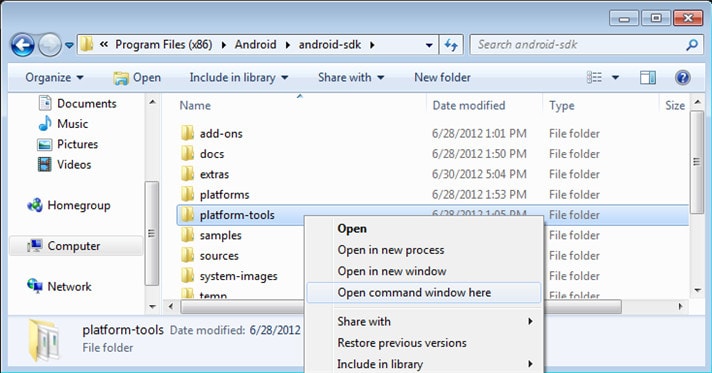
Step 4: Test the ADB
Here, we would like to test whether the ABD is working properly. To do this, connect your phone to the PC using a USB. In the command prompt, type adb services and then press enter. If it’s working properly, you should see a device on this list.

Step 5: Find the Android wifi password.
Now, it is time to type the given command in the command prompt and type: adb pull /data/misc/wifi/wpa_supplicant.conf c:/wpa_supplicant.conf. This will fetch the file from your phone to the local disc C drive of the PC.
Step 6: Get the wifi passwords.
Lastly, open the file with a notepad, and there you go.
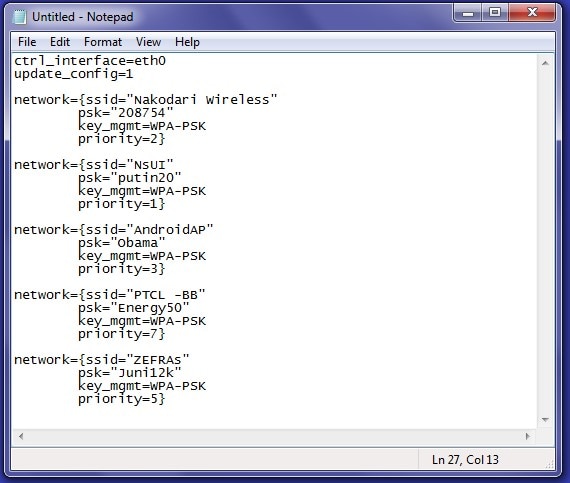
Now you learned how to show the wifi password on your Android device.
How To Unlock OnePlus Open Phone Without Password?
Has your Android smartphone been locked, and are you having trouble unlocking it now because you have forgotten phone password? Looking for methods to remove the password from your Android phone without doing a factory reset?
If the answer is “YES,” you’ve come to the correct spot.
Many people, including you, have had similar issues and wish to know how to unlock an Android phone without a password.
As a result, we have created some of the greatest guidelines or, you might say, top ways that may assist you in unlocking Android phones today, simply for you and countless other Android users.
Part 1: Unlock Your Locked Screen Without Password By 6 Efficient Ways
1. By your Google account
You can use your Google Account to unlock the Android phone password if, after several tries, you are still unable to do so without doing a factory reset.
You need to log into the Google account that is associated with the OnePlus Open device, then do the following:
- The unlock pattern may only be used five times before a notification telling you to try again in 30 seconds appears.
- “Forgot pattern” will show up at the bottom of the screen.
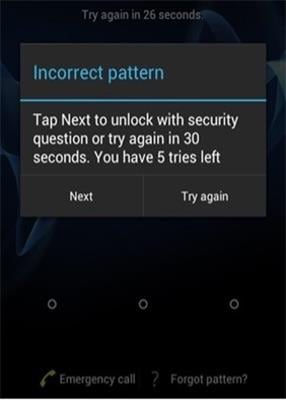
- You must enter the Gmail account that is associated with the OnePlus Open device here before selecting “Next.”
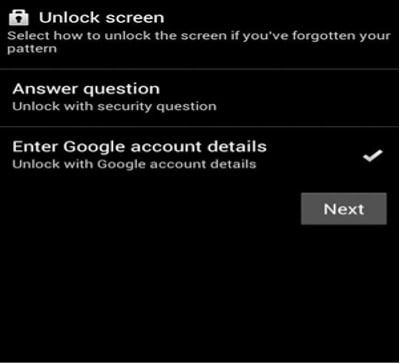
- That’s it; from this point forward, you may enter any new PIN or pattern that you can recall to unlock your smartphone.
2. Google Find My Device
Using your Google account is a superb method for finding the OnePlus Open device when lost or stolen.
In addition, it may be used to lock or ring your smartphone. You may have noticed that there are three options available when using this feature: “Ring,” “Lock,” and “Erase.”
To bypass the Android lock screen, all you need to do is sign into the OnePlus Open device’s associated Google account and then follow these steps:
- On any Android device or a computer, go to <www.google.com/android/find> and sign in using your Google account. Choose the Android smartphone you wish to unlock after that.
- After choosing the OnePlus Open device, select one of the three options, “lock,” from the list.
- There will be a new pop-up window that you can use to change the OnePlus Open device password. Additionally, you can choose to add a phone number or recovery email.
- Confirm it immediately, then input the password you just established on your locked device.
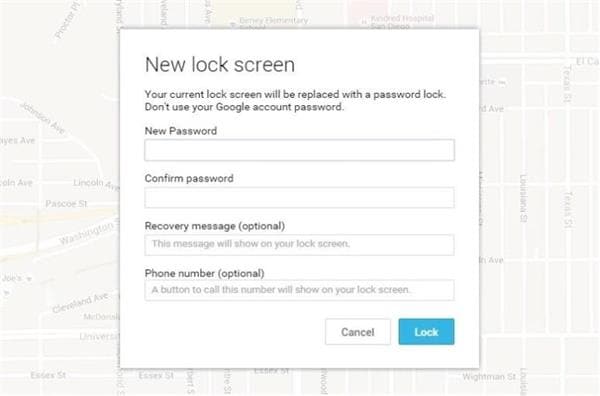
Many Samsung customers have this issue, which prevents them from using their devices. Try using the “Find My Mobile” feature on your mobile if you wish to unlock it if you’re a Samsung user. It would be helpful if you had a Samsung or Android model account.
After that, use Find My Device to unlock your Android phone without losing any data by following the instructions below:

- Sign in with your Samsung account at findmymobile.samsung.com.
- Choose “Lock my screen” from the menu on the left, type a new PIN in the box given, and then click “LOCK.”
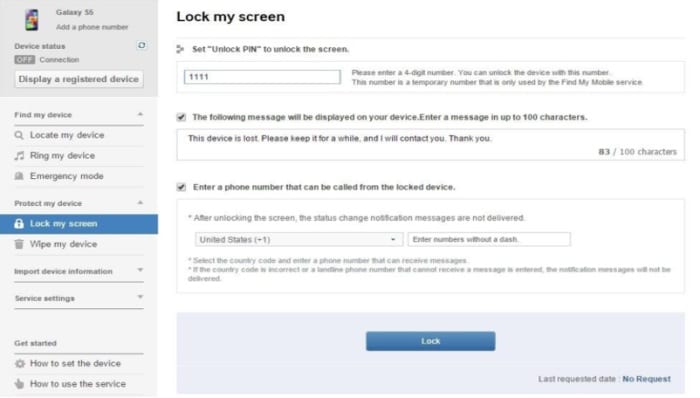
Your smartphone will be unlocked, and the password will be changed to the new one after a brief delay.
3. Use ADB (Android Debug Bridge)
Without a factory reset, Android phone passwords may also be unlocked using the Android Debug Bridge (ADB).
- You must first download ADB to your computer. Visit the Android developer’s website at https://developer.android.com/studio/command-line/adb.html to do this.
- Launch the installer after that to begin downloading crucial software for your machine.
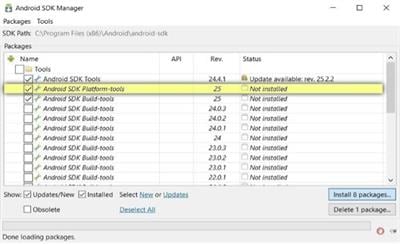
- Here, you must use a USB cable to connect your OnePlus Open to the computer
- This will activate the developer option on your smartphone if you navigate to Settings > About Phone > and choose the “Build Number” option seven times.
- After that, activate USB debugging by going to Settings > Developer Options.
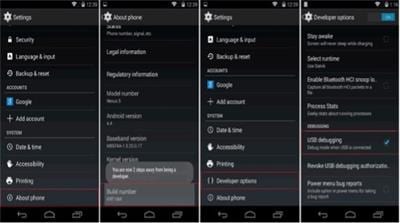
- Launch the command prompt in the ADB installation directory after your device is connected to the system.
- Press enter after typing “ADB shell rm /data/system/gesture.key” into the command line.
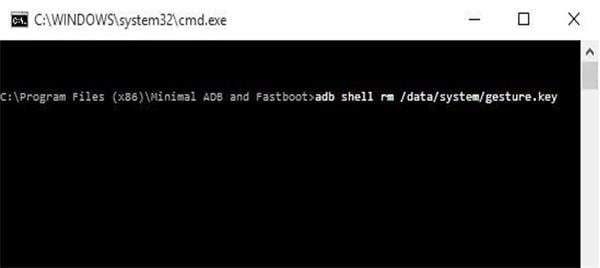
- Finally, just restart your smartphone and use it as normal.
4. Hard reset (data loss)
Each brand has a unique method for hard resetting a locked Android device. The methods to factory reset locked Android devices from Samsung, LG, HTC, Sony, and Huawei are compiled here.
When your phone is locked, you may access the recovery menu of your phone using its physical keys and choose to hard reset the OnePlus Open device. Here’s how to restore a locked phone to factory settings.
- Use the buttons to see the recovery menu.
- Press and hold the Volume Up and Side buttons simultaneously until you see the brand logo on the screen for Android devices without a Power/Bixby/Home button.
- Press and hold the Volume Up, Bixby, and Power buttons all at once if your smartphone has a Power button. Releasing them before a logo arises is advised.
- Use the Volume Down key to highlight Wipe data/factory reset when the Android system recovery option displays, then hit the Power/Bixby key to choose it.
- Allow a few seconds for the factory reset procedure to finish after selecting Yes, or Factory data reset. The phone will reboot once you pick the Reboot system. Now you may configure it as if it were a brand-new gadget.
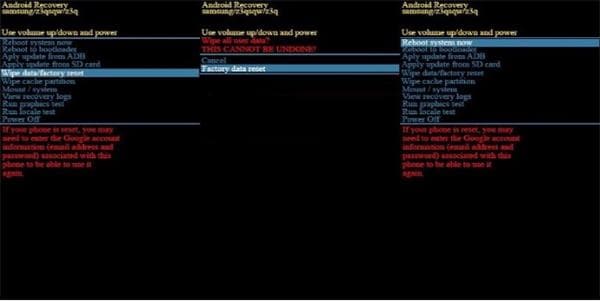
5. Unlock from Forgot Pattern (android 4.4 or lower)
This is another choice that might assist you in unlocking your phone without a factory reset or password. You may have observed that when pattern lock was enabled on your device, a security PIN question was also prompted at that time.
Therefore, you have the choice to Backup PIN, which might assist you in unlocking your smartphone, if you are unable to unlock it. To do it, take the following actions:
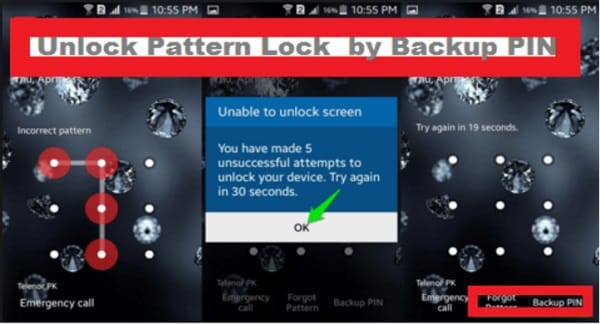
- Click on Android pattern lock.
- You’ll see a notification telling you to try again in 30 seconds after failing many times.
- The “Backup PIN” option will be there; choose it.
- Put the backup PIN and OK here.
- At last, you may unlock your cellphone by entering the backup PIN.
6. Boot into safe mode
Here’s how you can boot into safe mode.
- Hit the power button on your phone.
- Press and hold the volume down button on your phone as the animation begins. Hold it down until the animation is finished and your phone enters safe mode.
- “Safe mode” will be shown at the bottom of your screen.
- Out of safe mode
- Switch off your phone.
- Press the Power button on your phone for around 30 seconds, or until the OnePlus Open device restarts.
- You will see that after entering and booting into the safe mode, the lock option will not be visible.
- Then you will also see the option to turn off boot.
- You can get rid of the locked phone by proceeding with that option.
Part 2: Easy Tool To Unlock Android Phone Without Password
If you forget the lock code, you can simply unlock your Android phone using Dr.Fone - Screen Unlock.
Have you encountered the same situation? Do not fret. You may use Dr.Fone - Screen Unlock to unlock the screen lock on Android smartphones. It enables you to erase an Android phone’s password, PIN, pattern, and fingerprint.
Let’s learn how to safely remove the Android lock screen.
Step 1: Connect your phone
Open Dr.Fone on your PC, then select “Screen Unlock” from the list of tools.
The Dr.Fone functionality is still usable with the old UI of the Dr.Fone Mac version, but we will update it as soon as we can.
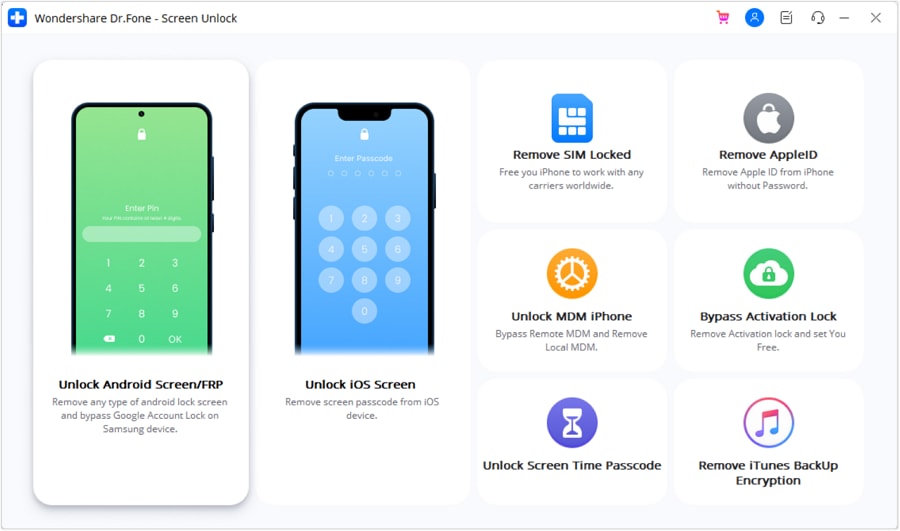
Connect your Android phone to the PC via a USB cable. then click the “Unlock Android Screen” button on the software.
Step 2. Choose a device model
Nearly all Android devices feature locked displays, including Android. Because the recovery kits for different phone models vary, it’s important to pick the correct device brand to unlock the lock. Every model of supporting hardware is included in the list.
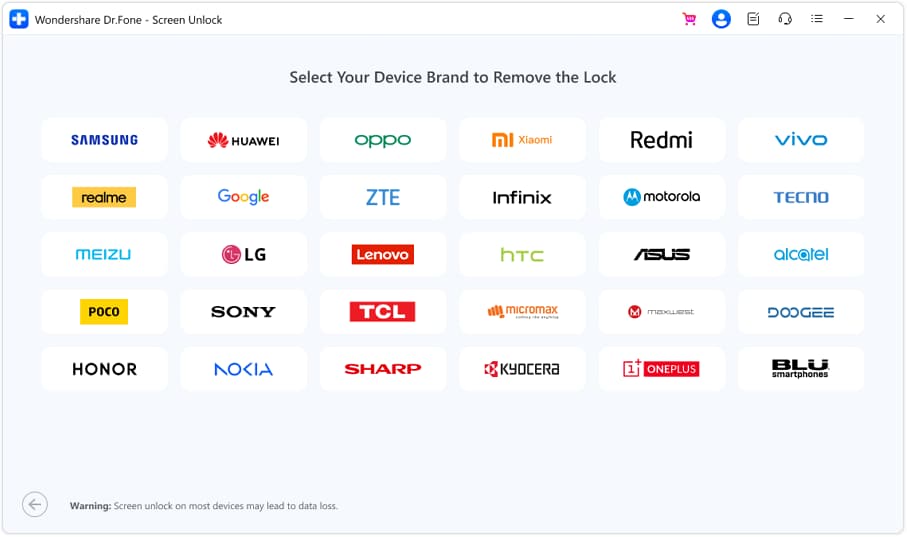
Step 3. Switch to download mode
If you then adhere to the instructions on the software, the phone will enter Download Mode.
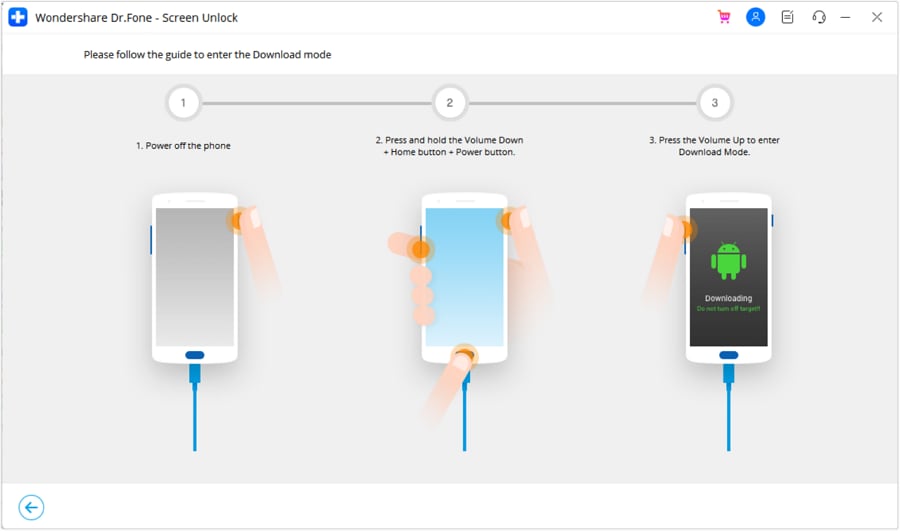
- Offset your phone.
- Hold down the Power, Home, and Volume Down keys all at once.
- Use the Volume Up button to start Download Mode.
- Remove the Android lock screen starting now..
Step 4. Download a package for recovery
The recovery package will begin downloading once you set your device in download mode. Wait only till it is completed.
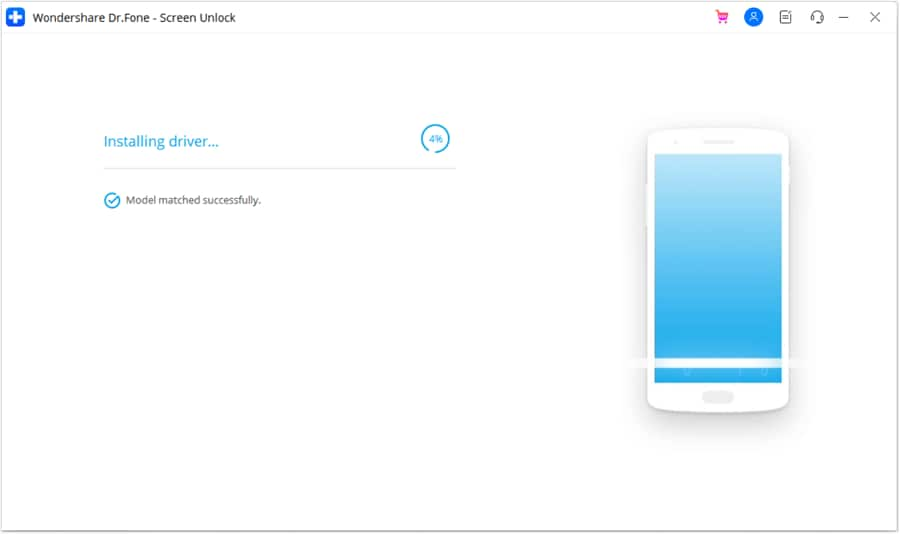
Step 5: Unlock Android without erasing data
After the recovery package download is finished, click “Remove Now.” This operation won’t harm any data on your Android device.
When everything is done, you won’t need to enter a password to access your Android smartphone, allowing you to see all of your data without any limitations.
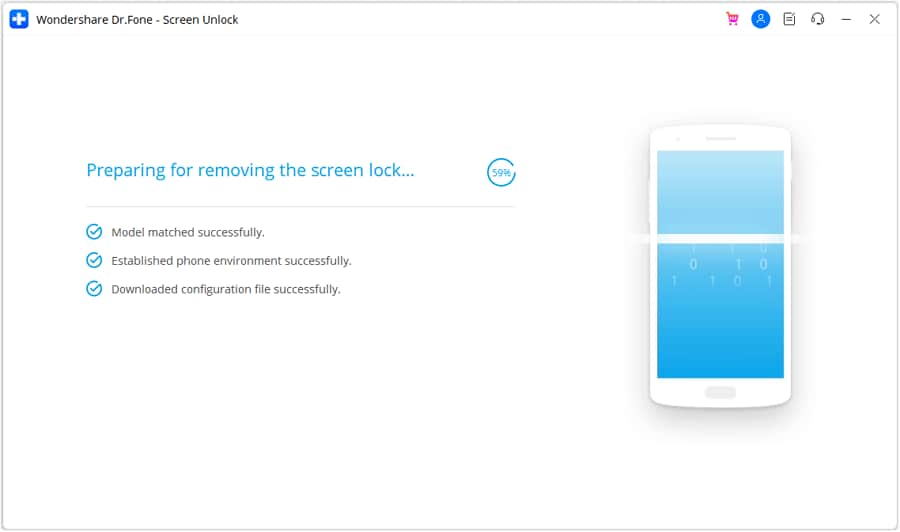
Bonus Tips: How To Keep Our Data Safe?
Dr.Fone - Phone Backup is an excellent solution to keeping data safe and secure and baking it up before resetting your device, even if you have forgotten your password. You may quickly and conveniently back up practically all forms of Android phone data with Dr.Fone - Phone Backup (Android). Additionally, you may examine and export only certain types of data.
Here’s how you can use Dr.Fone - Phone Backup to keep data safe.
Step 1: Connect your Android phone to your PC.

Open Dr.Fone on your PC, then select “Phone Backup” from the menu.
Next, join your Android phone to the computer with a USB cable. The phone must be in USB debugging mode, please. You will be prompted to approve USB Debugging in a pop-up window on the Android phone if your version of Android is higher. Press the OK button if you would.

Click Backup to start backing up the data on your Android device.
If you have previously used this programme to back up your device, you may review your backup history by clicking on “View backup history.”
Step 2: Choose which file types to backup.
Once the Android phone is connected, select the file types you want to backup. Dr. Fone has previously examined all the file types for you. After that, click Backup to start the backup process.
It will cost some time for the backup. Do not disconnect your Android phone from the computer, use it, or delete any data while making a backup.

When the backup is complete, you may click the View the backup button to see what’s in the backup file.
The Bottom Line
It would be best if you had been able to answer the question, “How to unlock an Android phone without password,” using the techniques we have demonstrated here. The most effective way for resetting an Android phone is Wondershare Dr.Fone - Screen Unlock for Android. You may quickly reset a locked Android phone without a password with only a few clicks.
Also read:
- [New] In 2024, Syncing Tunes with Video Cut & Paste YouTube Editor Basics
- [Updated] Captioning for Success Instagram Videos Edition
- [Updated] Creative Vlog Ideas for Daily Use
- 2024 Approved GiggleGraphics Visual Humor Studio
- Delete Gmail Account With/Without Password On Poco M6 5G
- How to Reset a Locked Oppo Reno 10 Pro+ 5G Phone
- How to Reset your Realme Narzo N55 Lock Screen Password
- How To Unlock Oppo Reno 10 5G Phone Without Password?
- In 2024, Best Choices Essential Support Gear for Your GoPro Camera
- In 2024, Full Tutorial to Bypass Your Motorola Edge 40 Neo Face Lock?
- In 2024, How Can We Unlock Our Poco C65 Phone Screen?
- In 2024, How To Remove the Two Factor Authentication On iPhone 12 Pro
- Is your Realme V30T working too slow? Heres how you can hard reset it | Dr.fone
- Title: In 2024, Rootjunky APK To Bypass Google FRP Lock For OnePlus Open
- Author: Aaron
- Created at : 2024-10-05 23:20:25
- Updated at : 2024-10-09 23:22:53
- Link: https://easy-unlock-android.techidaily.com/in-2024-rootjunky-apk-to-bypass-google-frp-lock-for-oneplus-open-by-drfone-android/
- License: This work is licensed under CC BY-NC-SA 4.0.